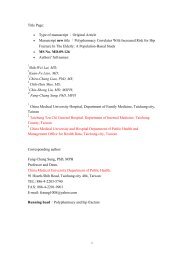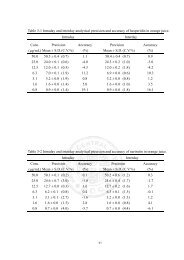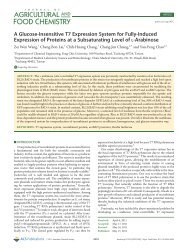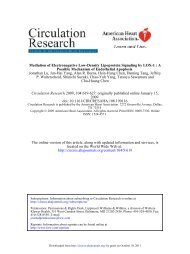Culinary Narratology in Everyday Life: Foodways and Identity ...
Culinary Narratology in Everyday Life: Foodways and Identity ...
Culinary Narratology in Everyday Life: Foodways and Identity ...
Create successful ePaper yourself
Turn your PDF publications into a flip-book with our unique Google optimized e-Paper software.
<strong>Cul<strong>in</strong>ary</strong> <strong>Narratology</strong> 18<br />
In this specific context, fish is regarded as a float<strong>in</strong>g signifier that simultaneously reveals<br />
<strong>and</strong> resists the coloniz<strong>in</strong>g impr<strong>in</strong>t of otherness <strong>in</strong> the form of reconfigured cul<strong>in</strong>ary heritage.<br />
The consumption of fish plays an essential part <strong>in</strong> Calcutta life. As Mrs. Sen recalls, she has<br />
grown up eat<strong>in</strong>g fish twice a day, <strong>and</strong> people <strong>in</strong> Calcutta eat fish “first th<strong>in</strong>g <strong>in</strong> the morn<strong>in</strong>g,<br />
last th<strong>in</strong>g before bed” (123). Eat<strong>in</strong>g fresh fish has become an <strong>in</strong>scribed urge with<strong>in</strong> Mrs.<br />
Sen’s body, <strong>in</strong>corporated <strong>in</strong> her daily life. In the US, where fresh fish is not easily to be<br />
acquired, “[i]t was always a whole fish she desired,” the narrative voice observes, “not<br />
shellfish, or the fillets that Eliot’s mother had broiled one night when she’d <strong>in</strong>vited a man<br />
from her office to d<strong>in</strong>ner” (123). Due to its scarcity, each time when she has fresh fish Mrs.<br />
Sen treats it very carefully: “she pulled the blade out of the cupboard, spread newspapers<br />
across the carpet, <strong>and</strong> <strong>in</strong>spected her treasures. One by one she drew them from the paper<br />
wrapp<strong>in</strong>g, wr<strong>in</strong>kled <strong>and</strong> t<strong>in</strong>ged with blood . . .” (127). This behavior with the fish is a way<br />
for Mrs. Sen to practice an important ritual <strong>in</strong> which she can f<strong>in</strong>d solace. To a certa<strong>in</strong> degree,<br />
the fresh fish gives Mrs. Sen the security of cultural belong<strong>in</strong>g.<br />
Lahiri uses Mrs. Sen’s hardships <strong>and</strong> set-backs <strong>in</strong> acquir<strong>in</strong>g fresh fish as ways of<br />
def<strong>in</strong><strong>in</strong>g the external parameters of her terra<strong>in</strong>, which is understood <strong>in</strong> terms of her kitchen or<br />
apartment (Kunow 168). Tragically, the route from Mrs. Sen’s apartment to the fish market<br />
symbolizes an obstacle course that exposes her predicament as an immigrant whose lack of<br />
mobility <strong>in</strong>dicates a lack of capability <strong>in</strong> construct<strong>in</strong>g a flexible identity. These<br />
<strong>in</strong>convenience <strong>and</strong> h<strong>in</strong>drance do not impede Mrs. Sen’s determ<strong>in</strong>ation on cook<strong>in</strong>g a fish <strong>in</strong> a<br />
traditional as well as authentic Bengali way. Due to the humiliat<strong>in</strong>g experience Mrs. Sen<br />
confronts on the bus while she was on her way home from seaside shop, 6 the second time<br />
when Mrs. Sen has to get the fish by herself, she prefers to risk driv<strong>in</strong>g to the seaside rather<br />
than take a bus. For once, she overcomes her fear <strong>and</strong> decides to use the car, tak<strong>in</strong>g Eliot<br />
along with her. Yet on the way to the fish shop she has an accident: “she is startled by other<br />
cars’ horn <strong>and</strong> hits a telephone pole on the opposite corner” (134). When the policeman









